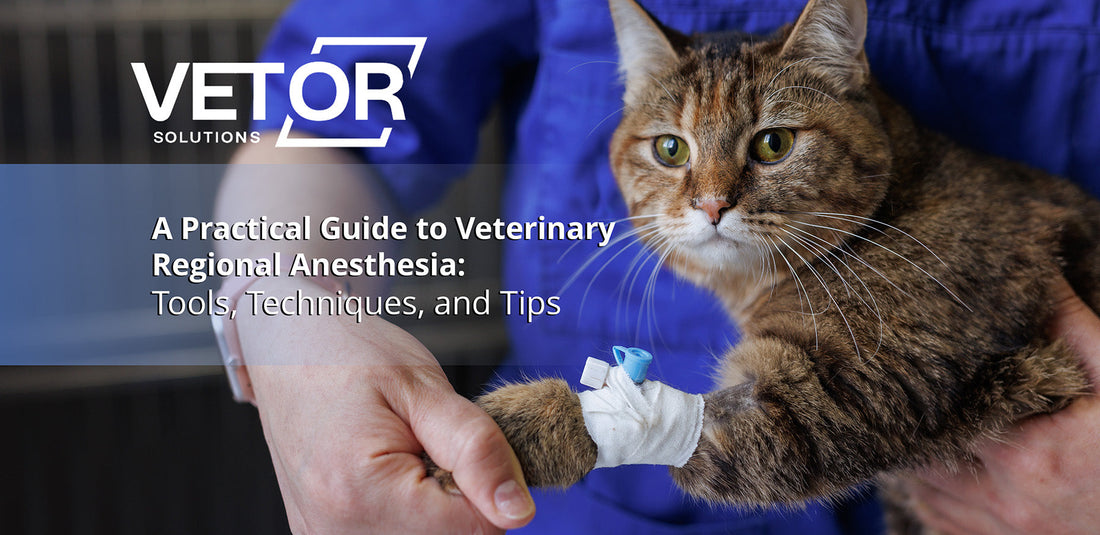A Practical Guide to Veterinary Regional Anesthesia: Tools, Techniques, and Tips
Regional anesthesia has become an indispensable tool in veterinary surgery. It not only reduces intraoperative and postoperative pain but also contributes to smoother recoveries, reduced reliance on systemic analgesics, and improved patient outcomes. As more veterinarians adopt multimodal analgesia protocols, regional anesthesia is finding its rightful place in small and large animal practices.
In this practical guide, we'll explore the essential tools, proven techniques, and useful tips for incorporating regional anesthesia into your daily veterinary practice. Whether you're just starting out or looking to refine your approach, this guide is designed to equip you with the knowledge and confidence to use regional blocks effectively and safely.
Why Regional Anesthesia Matters in Veterinary Medicine
Regional anesthesia provides targeted pain relief by blocking specific nerves or nerve plexuses that innervate the area of surgery. It offers several advantages:
- Reduced need for systemic opioids and inhalant anesthetics
- Improves patient comfort and recovery
- Less risk of anesthesia-related complications
- Lower anesthetic doses and better hemodynamic stability
Regional anesthesia is especially useful in orthopedic surgeries, dental procedures, abdominal interventions, and even minor soft tissue surgeries.
Core Tools of the Trade
Before performing any regional anesthesia, it's crucial to have the right tools in your kit. Here's a breakdown of the essentials:
1. Needles
- Spinal (Quincke or pencil-point) needles for epidurals
- Short-bevel insulated nerve block needles for peripheral nerve blocks (e.g., 22G x 50 to 100 mm)
- Dental needles for intraoral blocks
Choosing the right needle depends on the nerve block being performed, the size of the patient, and your chosen technique.
2. Syringes
- Use Luer-lock syringes to ensure safety when administering local anesthetic.
- 1 mL to 10 mL sizes are commonly used, depending on the volume needed.
3. Local Anesthetics
- Lidocaine: rapid onset, short duration (1 to 2 hrs.)
- Bupivacaine: slower onset, long duration (4 to 8 hrs.)
- Ropivacaine: similar to bupivacaine, with reduced cardiotoxicity
Always calculate dosage based on body weight and the maximum safe limits. Toxicity can be fatal, especially in small patients.
4. Nerve Stimulator (Optional)
- Confirm nerve proximity by observing muscle twitches in the area of innervation when placing peripheral nerve blocks.
5. Ultrasound Machine (Recommended)
- Increases block accuracy and reduces complications.
- High-frequency linear probe (6 to 13 MHz) for small animal applications.
- The Butterfly hand-held ultrasound is easy to use and provides excellent visualization
Foundational Techniques: What to Know Before You Start
1. Anatomical Knowledge is Key
Regional anesthesia is practical anatomy. Thoroughly understand the course of the nerve, the surrounding structures, and potential complications before beginning and nerve block. KNOW YOUR ANATOMY
For example:
- The brachial plexus runs medial to the shoulder joint and under the omotransversarius muscle in dogs. (strap muscle in the neck)
- The femoral nerve lies within the iliopsoas muscle.
2. Aseptic Technique
Always perform blocks under aseptic conditions to avoid introducing infections, especially with epidural or ultrasound-guided techniques.
3. Sedation or Light Anesthesia
Most patients will need sedation or light general anesthesia to maintain compliance during the procedure.
Common Regional Blocks in Veterinary Practice
The following are some of the most commonly used and practical regional blocks in small animal veterinary practice.
1. Epidural Anesthesia
Indication: Orthopedic procedures of hindlimbs, perineal surgeries, and caesarean sections
- Technique: Insert needle into the lumbosacral space (L7-S1) with the animal in sternal or lateral recumbency.
- Drugs: Bupivacaine (0.2–0.5 mg/kg), often combined with opioids like morphine for extended analgesia.
- Tip: Use the hanging drop technique or feel for the “pop” of the ligamentum flavum.
- Lumbar Epidural: for abdominal procedures as well as pelvic and lower extremity procedures if sufficient local anesthetic volume is given.
- Caudal Epidural: for perineal and pelvic procedures.


Lumbar Epidural Caudal Epidural
2. Brachial Plexus Block
Indication: Forelimb surgeries (elbow distal to the paw)
- Technique: Palpate just medial to the shoulder joint. The needle is directed towards the first rib. Peripheral nerve stimulators will improve your accuracy and success.
- Volume: 0.2 to 0.3 mL/kg of local anesthetic
- Tip: Ultrasound guidance improves accuracy and avoids vascular puncture.

Brachial Plexus Block with a Peripheral Nerve Stimulator
3. Femoral and Sciatic Nerve Block
Indication: Hindlimb orthopedic surgeries
- Technique:
- Femoral block: Aim within the iliopsoas muscle, cranial to the femoral artery.
- Sciatic block: Palpate between the greater trochanter and ischial tuberosity.
- Tip: Blocking both nerves is necessary for complete analgesia of the distal limb.
Femoral Nerve Block Sciatic Nerve Block
4. Maxillary and Mandibular Nerve Blocks
Indication: Dental procedures
- Technique:
- Maxillary: Approach via infraorbital foramen or caudal to the upper molars.
- Mandibular: Approach intraorally near the mandibular foramen.
- Tip: Avoid injecting blood vessels by aspirating before injection.

Mandibular Nerve Block
5. Line Blocks and Incisional Blocks
Indication: Abdominal surgeries, mass removals
- Technique: Infiltrate local anesthetic along the planned incision line or around a surgical site.
- Tip: These are simple but effective additions to multimodal analgesia.
Tips for Successful Regional Blocks
Dos and Don’ts
- DO use sedation or anesthesia for comfort and safety.
- DO aspirate before injection to avoid intravascular administration.
- DO calculate doses carefully based on lean body mass.
- DON’T use epinephrine-containing solutions near extremities or tissues with end-arterial blood supply.
- DON’T exceed maximum safe dosages, especially in cats and small dogs.
Clinical Pearls
- Combine techniques: For example, an epidural combined with local infiltration offers extended and layered pain relief.
- Monitor closely: Look for signs of toxicity (e.g., tremors, seizures, bradycardia) and be prepared to treat.
- Practice on cadavers or models to build confidence before performing on live animals.
- Document the drug, volume, site, and any adverse reactions in the medical record.
Safety Considerations and Managing Complications
Local Anesthetic Toxicity
Local anesthetic toxicity can be life-threatening. Signs include:
- CNS toxicity: seizures, tremors, altered mental status
- Cardiovascular toxicity: bradycardia, hypotension, arrhythmias
Treatment: Supportive care, intravenous lipid emulsion (Intralipid 20%), seizure control (e.g., diazepam). Have all your drugs ready for administration should the patient have a seizure.
Nerve Damage
Minimize the risk of nerve damage by:
- Avoiding forceful injection
- Not injecting against resistance
- Using ultrasound to confirm needle position
Contraindications
- Infection at the site of intended nerve block
- Coagulopathies (especially for epidural procedures in which intra-epidural space bleeding can lead to spinal cord compression)
- Known allergies to local anesthetics
Regional Anesthesia in Large Animals
Small animal regional anesthesia is more commonly discussed; however, its use in equine and bovine practice is equally important:
- Equine: Local blocks for standing surgeries (e.g., digital nerve blocks, epidurals, auriculopalpebral blocks)
- Bovine: Common blocks include paravertebral, inverted L, and caudal epidural for obstetrical procedures
These blocks are critical for restraint, analgesia, and surgical procedures in the field.
Final Thoughts: Building Regional Anesthesia into Your Practice
Regional anesthesia is more than just a technique; it’s a mindset. Use regional nerve blocks whenever you can to improve your patient’s postoperative course. By integrating it into your routine, you improve animal welfare, optimize outcomes, and become a more versatile veterinary professional.
To get started:
- Start simple: Incorporate line blocks or dental blocks.
- Train continuously: Attend workshops or CE courses.
- Invest in guidance tools: An ultrasound machine can pay dividends in patient safety and procedural confidence. The Butterfly ultrasound is handheld, versatile, and cost-effective.
Veterinary medicine is evolving rapidly, and pain management is at the forefront. Embracing regional anesthesia is a step toward more compassionate, innovative, and effective care for your patients.
Further Reading & Resources:
- Campoy, Luis & Read, M.R.. (2013). Small Animal Regional Anesthesia and Analgesia. 10.1002/9781118783382.
- Valverde A, Sinclair M. Veterinary Anesthesia Techniques. Saunders.
- Online CE courses available through VIN, VetBloom, and NAVC.
Products to Augment Regional Anesthesia:
Regional anesthesia techniques provide excellent intraoperative anesthesia and remarkable postoperative patient comfort. Secure and comfortable patient positioning also provides intraoperative patient comfort and complements the postoperative comfort provided by your regional anesthetic techniques. The HUG-U-VAC positioners have long been the standard of positioning care.














